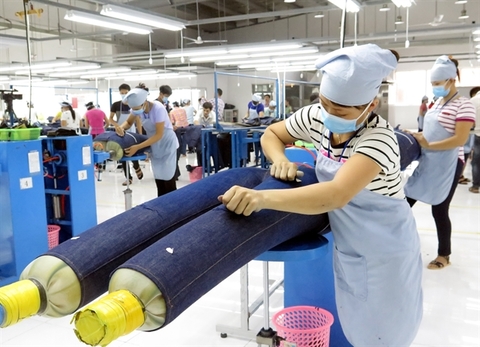Opening Vietnam up to Industry 4.0
Opening Vietnam up to Industry 4.0
The country’s big potential in IT and large smartphone penetration are the key enablers for Vietnam to develop its digital economy. However, a national strategy for 4.0 and sturdy policies in favour of the business community to apply IT solutions is in an urgent need.
At the Vietnam Private Sector Economic Forum 2019 held last week in Hanoi, one of the biggest questions raised was whether Vietnam is now lagging behind the global digital economic waves created by Industry 4.0.
“How will the Vietnamese economy develop in the future without riding the global digital waves hitting the country?” asked Nguyen Trung Chinh, chairman of IT firm CMC Corporation. “How will the country seize the vast opportunities given by Industry 4.0 to develop its digital economy to reach into its own immense potential?”
Digital economy refers to an economy that is based on digital computing technologies.
According to Bui Quang Ngoc, vice chairman of IT giant FPT Group, over the past few years there have been almost no specific policies and actions for developing a digital economy in Vietnam. “For example, in the public administration, programmes on e-government, e-tourism or e-healthcare have failed to be implemented effectively,” Ngoc said.
“A legal framework on applying IT or developing smart solutions has not been implemented either. There has been a gap between policy and action, and while the concept of 4.0 has been widely talked about, few actions have been made – even as the country is bursting with opportunities to develop a digital economy.”
GREAT OPPORTUNITIES
At the forum, Deputy Minister of Planning and Investment Vu Dai Thang said that the digital economy is surging in Vietnam, creating major changes in business methods. “Vietnam has great opportunities to develop a digital economy because it has immense potential,” Thang said.
He cited a recent survey by Google and Singapore’s Temasek valuing Vietnam’s digital market at $3 billion in 2015 and $9 billion in 2018, and estimated it to rise to $30 billion by 2025. Meanwhile, a recent study by Data 61, Australia’s data innovation network, showed that Vietnam’s GDP could rise by an additional $162 billion within 20 years if Vietnam succeeded in digital transformation.
According to the Asia Internet Coalition (AIC), with a population of nearly 100 million people, Vietnam is among the few nations in Southeast Asia with the highest speed of digital transformation. Currently, Vietnam has more than 136 million mobile phone subscribers and 54.2 per cent of the population are connected to broad-band wire-based Internet. Vietnam is also one of 17 nations in the world with the biggest number of Internet users. The Vietnamese government aims to turn the country into one of the 10 largest nations in the world producing software and digital content.
“We think this target will be easily reached thanks to Vietnam’s strong telecommunications industry,” said Do Khanh Ly, AIC representative in Hanoi.
“Vietnam’s online advertising market and e-commerce are also developing strongly. According to the Vietnam E-Commerce Association, the country’s e-commerce market is estimated to be over $5 billion now and can double over the next four years,” Ly said. “The impact of the Internet on the economy is estimated to be equivalent to 2-3 per cent of the GDP, which may increase to 40-50 per cent in the future.”
At a recent workshop on unlocking the full potential of Vietnam’s digital economy in Hanoi, Quint Simon, head of Public Policy in Southeast Asia at Amazon Web Services (AWS), surprised hundreds of business leaders and experts by announcing that Vietnam is one of the nations with the fastest growth of 64 per cent per annum in spending on cloud computing.
AWS is a subsidiary of Amazon.com that provides on-demand cloud computing platforms to individuals, companies, and governments.
“I believe that in the near future Vietnam will develop a digital economy successfully. Cloud computing is a favourite in Vietnam, with many enterprises using it,” Simon said, explaining that with the cloud, businesses can completely protect their information and prevent it from being stolen.
“For example, Amanotes, a fast-growing app publisher, currently has hundreds of millions of users. It is typical of Vietnamese businesses with cloud computing,” Simon continued. “In another case, Masan is also using cloud to manage its stores in Vietnam. It has been a big trend that many Vietnamese agencies and enterprises are seeking our support in cloud applications.”
NATIONAL STRATEGY FOR 4.0
Deputy Minister Thang said that in order for Vietnam to seize opportunities and facilitate enterprises to benefit from Industry 4.0, the Ministry of Planning and Investment (MPI) is compiling a national strategy on Industry 4.0, which will clarify what the digital economy means, with specific tasks for ministries and agencies.
The strategy’s prime targets are to grab opportunities arising from Industry 4.0, increase the country’s GDP and employment, and attract more high-quality foreign direct investment.
“With this strategy, Vietnam stands ready to receive new technologies. However, the country will have to adapt many policies to Industry 4.0,” said Nguyen Thi Tue Anh, vice head of the MPI’s Central Institute for Economic Management (CIEM) which is drafting the strategy.
Under the CIEM’s study on the draft, Industry 4.0 would likely raise Vietnam’s GDP by $28.5-62.1 billion, equivalent to a rise of 7-16 per cent, from now to 2030.
“The benefits for Vietnam will be huge, far higher than those from the Comprehensive and Progressive Agreement for Trans-Pacific Partnership, which will increase Vietnam’s GDP by 1.32 per cent by 2035,” said Dang Quang Vinh, deputy chief of the CIEM’s Department of Business Environment and Competitiveness.
“Besides, Vietnam will be able to generate 1.3-3.1 million new jobs by 2030 thanks to Industry 4.0,” said Vinh, who is one of the drafters of the strategy. “However, these benefits will only materialise if we have more sturdy policies in favour of the business community.”
According to the CIEM, if medium-level technologies are applied, Vietnam’s Industry 4.0 strategy will likely enable the country to see strong growth in many key economic sectors by 2030 such as manufacturing (16 per cent), wholesale and retail (20 per cent or $9.5 billion), agro-forestry-fishery (12 per cent or $6 billion), supply of electricity, gas, and air conditioning (23 per cent), and finance-banking-insurance (14 per cent or $3.5 billion).
For example, the manufacturing sector will grow by an additional $7-14 billion based on new technology applications, while the communications and industry sector will climb 77 per cent, or an additional $2.5 billion compared to the scenario where the country fails to follow Industry 4.0.
According to the CIEM, new industries arising from Industry 4.0 “will be the key growth propellants for Vietnam, such as the Internet of Things and media. They will also support other sectors by raising their competitiveness, revenue, and developing new products and services.”
The new industries will include e-commerce ($40 billion in revenue by 2030), Artificial Intelligence ($420 million), data analysis ($730 million), cloud computing ($2.2 billion), ride-hailing ($2.2 billion), and fintech ($1.5 billion).
Currently, many nations have been developing their Fourth Industrial Revolution strategies, such as Made in China 2025; Japan Resuscitation Strategy; Malaysia’s My-i4.0; Singapore’s 23 plans on digital transformation; India’s Smart City Mission and Industry 4.0 Centre; Indonesia’s Making Indonesia 4.0; and Thailand 4.0.
“Industry 4.0 offers great opportunities to Vietnam without which, the country will continue lagging behind other nations,” said the CIEM study. “Taking advantage of Industry 4.0 is the shortest way for Vietnam to turn itself into a modern and affluent nation, and develop into a modern industrial nation in the shortest time. Thus, the country needs to mobilise all necessary resources to implement its Industry 4.0 strategy.”
A PROPER LEGAL FRAMEWORK
At the Vietnam Private Sector Economic Forum 2019 last week, CIEM deputy director Nguyen Duc Hieu said that it would be difficult to develop a sturdy legal framework to regulate activities related to the digital economy.
“For example, if an unmanned car causes an accident, who will be largely responsible? Is it the car, the software owner, the car owner or even road designers? We will have to have suitable laws for such cases,” Hieu said.
According to Minister of Information and Communications Nguyen Manh Hung, several key foundations need to be developed to create an effective digital economy in Vietnam.
“When we dare to accept new things, new technologies and global talent will come to Vietnam and new industries will appear,” Hung said. “Then Vietnam will be able to create digital products that can be exported.”
“However, if we dare to accept new things but only follow other nations, we will not be able to create many added-value products,” Hung continued.
According to him, the digital economy in Vietnam must be supported by a good ICT infrastructure characterised by 5G technology and each person in the country owning a smartphone.
“Second, we need to have good policies to spur digital economy and technology. Internet in Vietnam must be globally competitive so that Vietnamese people will not go overseas to establish their enterprises any longer and more foreign enterprises will come to Vietnam to do business,” he said.
“Third, the government needs to develop an initial market for IT enterprises by spending more on IT products and e-government,” Hung added. “Finally, human resources training needs a boost in foreign languages and IT education in schools and universities.”







